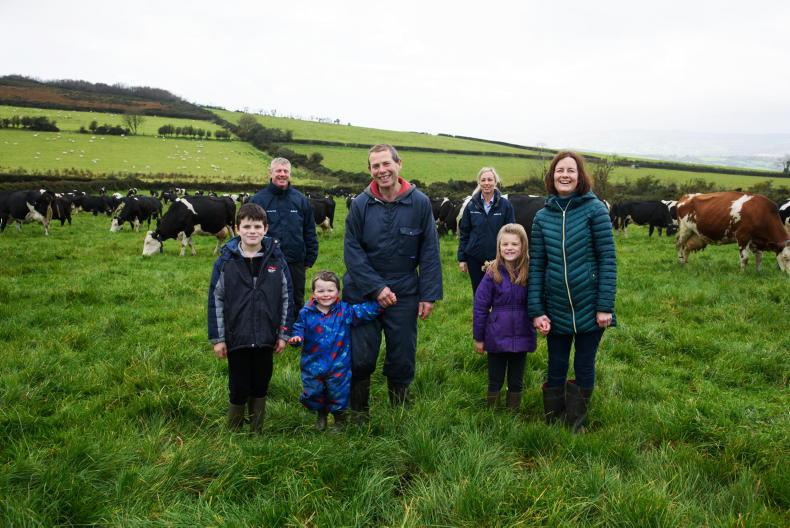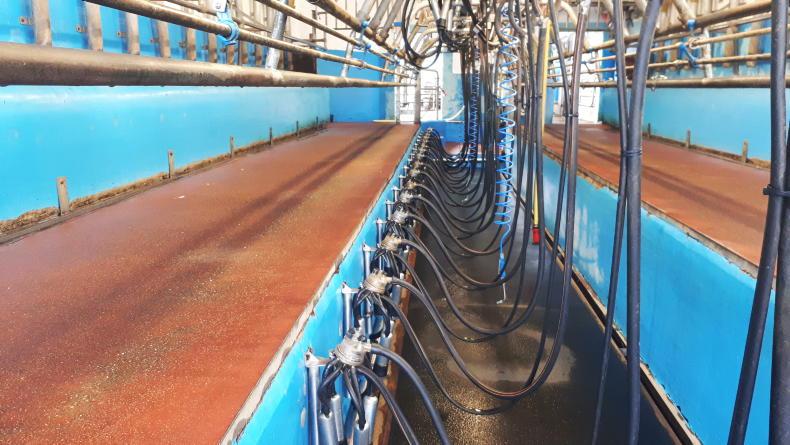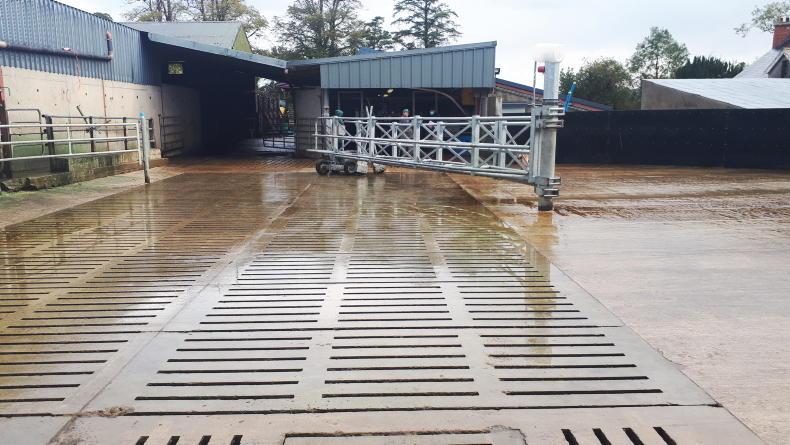Richard and Wendy Starrett farm with their young family David, Holly and John at Killendarragh, Lifford, Co Donegal.
The moment you drive into the farm at Lifford, you get a feel for the business and what is important. Mature trees dot the landscape on the low-lying fields, and the farm roadway zig-zags across the hill as you make your way to the farmyard. Grey squirrels danced out of our way into the lush green grass on either side. The farm is effectively on the side of a hill looking down over Lifford and into Strabane on the other side of the border.

Richard Starrett with his family and Aurivo farm advisers Paul Cullinane and Majella McCafferty. Richard Starrett, dairy farmer Donegal. \ Clive Wasson
Richard’s grandfather purchased the farm in 1934 and then Richard’s father John spent years draining, ploughing, liming and reseeding until Richard took over the farm in 1994 after completing his Green Cert. Since 2012 the herd has grown from 80 to 160 cows as Richard purchased more land adjoining the home farm.
East Donegal gets plenty of rain and this high and exposed farm is open to the elements every day of the year. The lowest point of the farm is at sea level but it rises rapidly to 600ft above sea level.
Last year, the high-EBI herd averaged 556kg of milk solids on 1.1t of meal and grazed grass. Richard said last year was exceptional and he would normally feed 800kg to 900kg of meal but the weather was very wet in Donegal in 2019.

Richard Starrett's parlour.
Richard has been interested in breeding for a long time and has followed the development of the EBI, sticking with high milk solids black and white sires all through his farming career. The six-week calving rate on the farm is 84% and calving interval is very good at 370 days. There are 55ha available to the herd, with 66ha farmed in total. In 2019, the farm grew 14.4t DM/ha.
In 2009 Richard started farming as a company and believes for his business it has saved him paying a lot of tax, allowing him invest in improving the infrastructure on the farm. Some of the investments in the yard over the last 10 years included air drafting gates, an automatic calf feeder, a circular collecting yard, solar panels that heat milking parlour water and power the coolers, LED lighting and a new calf shed.

Milk jugs.
One area Richard is very interested in is selective dry cow therapy. He said: “We treated 34 cows of the 160 last year with antibiotics and this year I hope to reduce that number to fewer than 20 cows.”
Richard sets his treatment threshold at 150,000 SCC, ie all cows under 150,000 don’t get antibiotics. Only infected cows receive antibiotics at drying off.
Managing runoff from yards, farm roads etc is essential. Richard is keen to maximise the farm’s potential to grow grass and so has invested significantly in soil fertility over the last 10 years to optimise grass growth. The farm is in derogation so the whole farm is soil tested every two years.

The collecting yard.
The Finn catchment is heavily monitored and Catchment Care has been doing ongoing survey work and monitoring of the Finn River, which runs very close to the farm. Richard has been using square bales of straw to catch sediment and nutrient runoff at clean water outlets during periods of exceptionally heavy rain to minimise runoff from entering clean water sources. Richard has pockets of trees, gorse and hedgerows around the farm. Hedgerows are maintained annually and for the last 10 years Richard has left trees grow and mature every 50 metres in the ditches.

Richard Starrett on his farm. \ Clive Wasson
There is no doubt this is a difficult farm to manage but, when measured and managed properly, it is clear it can grow plenty of grass.
Cow numbers 2019: 160Herd EBI: €181Total milk delivered (2019): 1,055,205Total milk solids (2019): 85,465Fat % average: 4.57%Protein % average: 3.96%Milking parlour: 21 unit herringboneWeighted TBC average (2019): 10Weighted SCC average (2019): 130Detergent used parlour: Autoscan BlueDetergent used bulk tank: Autoscan BlueProportion of herd using selective dry cow therapy (SDCT): 80%Nitrogen used (kg/ha): 230Proportion protected urea: 30%Measure grass: yes
Read more
Lakeland lead the best of the rest
Nigeria - 200 million people need dairy protein
Richard and Wendy Starrett farm with their young family David, Holly and John at Killendarragh, Lifford, Co Donegal.
The moment you drive into the farm at Lifford, you get a feel for the business and what is important. Mature trees dot the landscape on the low-lying fields, and the farm roadway zig-zags across the hill as you make your way to the farmyard. Grey squirrels danced out of our way into the lush green grass on either side. The farm is effectively on the side of a hill looking down over Lifford and into Strabane on the other side of the border.

Richard Starrett with his family and Aurivo farm advisers Paul Cullinane and Majella McCafferty. Richard Starrett, dairy farmer Donegal. \ Clive Wasson
Richard’s grandfather purchased the farm in 1934 and then Richard’s father John spent years draining, ploughing, liming and reseeding until Richard took over the farm in 1994 after completing his Green Cert. Since 2012 the herd has grown from 80 to 160 cows as Richard purchased more land adjoining the home farm.
East Donegal gets plenty of rain and this high and exposed farm is open to the elements every day of the year. The lowest point of the farm is at sea level but it rises rapidly to 600ft above sea level.
Last year, the high-EBI herd averaged 556kg of milk solids on 1.1t of meal and grazed grass. Richard said last year was exceptional and he would normally feed 800kg to 900kg of meal but the weather was very wet in Donegal in 2019.

Richard Starrett's parlour.
Richard has been interested in breeding for a long time and has followed the development of the EBI, sticking with high milk solids black and white sires all through his farming career. The six-week calving rate on the farm is 84% and calving interval is very good at 370 days. There are 55ha available to the herd, with 66ha farmed in total. In 2019, the farm grew 14.4t DM/ha.
In 2009 Richard started farming as a company and believes for his business it has saved him paying a lot of tax, allowing him invest in improving the infrastructure on the farm. Some of the investments in the yard over the last 10 years included air drafting gates, an automatic calf feeder, a circular collecting yard, solar panels that heat milking parlour water and power the coolers, LED lighting and a new calf shed.

Milk jugs.
One area Richard is very interested in is selective dry cow therapy. He said: “We treated 34 cows of the 160 last year with antibiotics and this year I hope to reduce that number to fewer than 20 cows.”
Richard sets his treatment threshold at 150,000 SCC, ie all cows under 150,000 don’t get antibiotics. Only infected cows receive antibiotics at drying off.
Managing runoff from yards, farm roads etc is essential. Richard is keen to maximise the farm’s potential to grow grass and so has invested significantly in soil fertility over the last 10 years to optimise grass growth. The farm is in derogation so the whole farm is soil tested every two years.

The collecting yard.
The Finn catchment is heavily monitored and Catchment Care has been doing ongoing survey work and monitoring of the Finn River, which runs very close to the farm. Richard has been using square bales of straw to catch sediment and nutrient runoff at clean water outlets during periods of exceptionally heavy rain to minimise runoff from entering clean water sources. Richard has pockets of trees, gorse and hedgerows around the farm. Hedgerows are maintained annually and for the last 10 years Richard has left trees grow and mature every 50 metres in the ditches.

Richard Starrett on his farm. \ Clive Wasson
There is no doubt this is a difficult farm to manage but, when measured and managed properly, it is clear it can grow plenty of grass.
Cow numbers 2019: 160Herd EBI: €181Total milk delivered (2019): 1,055,205Total milk solids (2019): 85,465Fat % average: 4.57%Protein % average: 3.96%Milking parlour: 21 unit herringboneWeighted TBC average (2019): 10Weighted SCC average (2019): 130Detergent used parlour: Autoscan BlueDetergent used bulk tank: Autoscan BlueProportion of herd using selective dry cow therapy (SDCT): 80%Nitrogen used (kg/ha): 230Proportion protected urea: 30%Measure grass: yes
Read more
Lakeland lead the best of the rest
Nigeria - 200 million people need dairy protein











 This is a subscriber-only article
This is a subscriber-only article











SHARING OPTIONS: